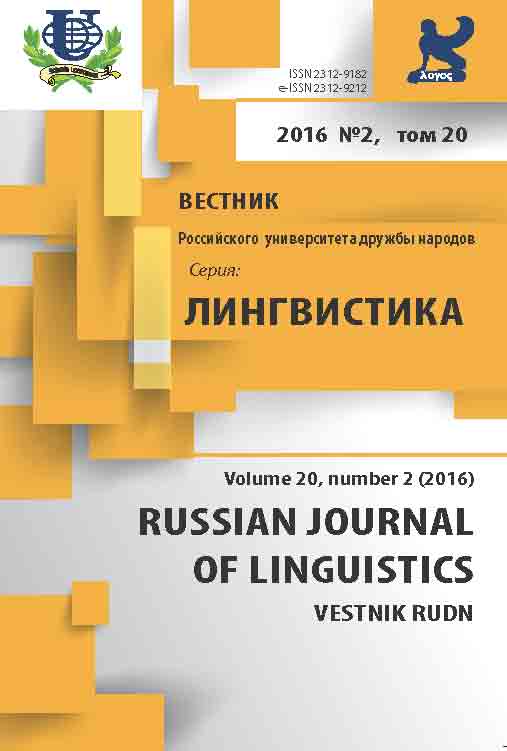Semantics of Kinship Terms in Tamil from the Semantic Typology Point of View
- Authors: Smirnitskaya A.A.1
-
Affiliations:
- Institute of Oriental Studies of the Russian Academy of Sciences
- Issue: Vol 20, No 2 (2016)
- Pages: 112-127
- Section: Articles
- URL: https://journals.rudn.ru/linguistics/article/view/14710
Cite item
Full Text
Abstract
In this article the author examines the lexical-semantic group “kinship terms” in Tamil, applying the attainments of modern semantic typology and the theory of semantic derivation. The kinship terms describing nuclear and extended family are explored. The “semantic shift” relation between two different meanings is established if such relation is realized by synchronous polysemy in one lexeme, semantic derivation, diachronic semantic change, cognates or some other means. The starting point of the study is the typological data from the DatSemShift catalogue of semantic shifts in languages of the world developed by a group of researchers under the guidance of Anna A. Zalizniak in the Institute of Linguistics, RAS. We verify the presence of semantic shifts described in the Database in Tamil. Also, we propose new semantic shifts specific only for this language. We confirm the presence of semantic relation of the studied type among the meanings with English “labels”: father - parents, girl - daughter, to deliver (a child) - parents, - child, old woman - wife, owner - wife and others. The data also allows the assumption that the same relation exists between the meanings: old - grandfather, earth - mother, son - courage, unripe - son and others. The meanings of this field are the sources of semantic movements to abstract notions, lexicon of posession, forms of address and others; in addition many inner semantic relations inside this field are revealed. The meanings covering the nuclear part of the kinship system participate in universal semantic shifts described in the DatSemShift catalogue, while the meanings from collateral branches of this bifurcative kinship system (uncle, aunt) turn out to be incomparable with kinship terms from indo-european lineal systems. Their meanings can be included in the DatSemShift catalogue only with an indication of system specifics. The information about semantic shifts can be useful for explanatory and translation dictionaries, for anthropological research and for reconstruction of meaning in historical linguistics. Systematic understanding of the semantic connections in the kinship terms allows a different vision of their place in the conceptual space of the Tamil culture.
Keywords
About the authors
Anna Aleksandrovna Smirnitskaya
Institute of Oriental Studies of the Russian Academy of Sciences
Email: nyushas@gmail.com
Rozhdestvenka str., 12/1, Moscow, Russia, 107031
References
- DatSemShift - M. Bulakh, D. Ganenkov, I. Gruntov, T. Maisak, M. Rousseau, A.A. Zalizniak. Database of semantic shifts in the languages of the world, DatSemshifts 2012-2013. URL: semshifts.iling-ran.ru.
- Аллен Н.Дж. Начальный этап эволюции терминологии родства дравидийского типа // Алгебра родства: Родство. Системы родства. Системы терминов родства. СПб., 1995. Вып. 1.
- Зализняк А.А. Многозначность в языке и способы ее представления. М.: Языки славянских культур, 2006. (Studia philologica).
- Зализняк А.А. Семантический переход как объект типологии // Вопросы языкознания. 2013. № 2. С. 32-51.
- Качинская И.Б. Термины родства и языковая картина мира (по материалам архангельских говоров): Автореферат дисс. М., 2011.
- Мердок Дж.П. Социальная структура. Пер. с англ. А.В. Коротаева. М.: ОГИ, 2003.
- Михайлова Т.А. О логике семантической деривации в возникновении и эволюции терминов свойства: др. ирл. aithech tige vs. др. англ. husband // Вестник МГУ. Серия 9. Филология. 2013. № 4. С. 126-137.
- Падучева Е.В. Динамические модели в семантике лексики. М.: Языки славянской культуры, 2004.
- Рахилина Е.В. Когнитивный анализ предметных имен: семантика и сочетаемость. Изд. 2, испр. и доп. М.: Азбуковник, 2010.
- Старостин Г.С., ред. Аспекты компаративистики. Вып. 4. М.: Изд-во РГГУ, 2009. (Orientalia et Classica: Труды Института восточных культур и античности. Выпуск XXVIII.)
- Толстая С.М. Категория родства в этнолингвистической перспективе. М., 2009. (Категория родства в языке и культуре. М., 2009. С. 7-22.)
- Трубачев О.Н. История славянских терминов родства и некоторых древнейших терминов общественного строя. М.: КомКнига, 2006.
- Шапошникова Л.В. Элементы материнского рода в племенной организации, традициях и обычаях тода // Серия «Востоковедение». 1977. № 1.
- Koch Peter. Lexical typology from a cognitive and linguistic point of view. In Martin Haspelmath; Ekkehard König; Wulf Oesterreicher & Wolfgang Raible, Language typology and language universals: An international handbook. Vol. 2. Berlin & New York: Walter de Gruyter, 2001. P. 1143-1175.
- Larina T., Suryanarayan N. English and Hindi address forms in a bilingual context // Cognitive Psycholinguistics: Bilingualism, Cognition and Communication: 35-th International LAUD Symposium. LAUD Linguistic Agency, University of Duisburg - Essen, Germany, 2012. P. 199-220.
- Trawick M. Notes on Love in a Tamil Family. University of California Press, Berkeley, 1992.
- Vanhove M. (ed.) From polysemy to semantic change. Towards a typology of lexical semantic associations. (Studies in language companion series, 106.) Amsterdam, 2008.
- Русско-тамильский словарь. Сост. М.С. Андронов, А.Ш. Ибрагимов, Н.Н. Юганова, Е.И. Коновалов. М., 1989.
- Тамильско-русский словарь. Сост. А.М. Пятигорский, С.Г. Рудин. М., 1960.
- Cre-A: Online Tamil Language Repository: http://www.crea.in/index.php?wrdopt=corpus& startwort=%E0%AE%B5%E0%AE%A3%E0%AE%95%E0%AF%8D%E0%AE%95%E0%AE%AE%E0%AF%8D&ispost=0.
- Kriyavin tarkalat tamiz akarati. tamiz-tamiz-ankilam. Chennai, 2008.
- Tamil lexicon. Madras: University of Madras, 1924-1936.

















